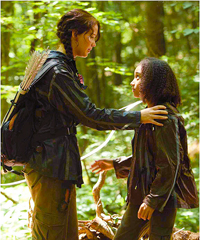
| It’s a quite striking experience to see specificly that film at the Sony Center in Berlin, where I went to attend an original language version. Upon exit one needs some seconds to realize that the light blue sky lit up above when leaving the evening screening of the film is a reality not too diverse from that exaggerated artificial and decadent one of the movie. Cycling back to my district, and I guess it doesn’t matter much if it is a potholed, still unrepaired former east street in Berlin Mitte or somewhere in Kreuzberg, Wedding or Pankow – it all feels a bit like district – when coming from ‘the center’. | |
| The Hunger Games is an interesting, though in terms of action almost boring film. Nevertheless it embeds a play with the idea that the existential world is embodied by the poor in their classified districts which is impacted by the – let’s address it as the generated virtual – influence of the rich, a decadent and cynic – in a way disembodied society which nevertheless desires to get some sensation of the ‘real’. The ‘real’ is attributed to a game of existential violence between randomly selected youngsters from the districts. The grotesque society of the establishment seems to be in desperate desire of sensations though but is at the same time that much detached from experiencing that it seems de facto unaware of struggle and pain. Such a congruity of modern disembodiment seems to very straight forwardly enable an understanding of why this world of existentialism strictly belongs to teens and outsiders. |  |
| And it has another parable at hand – the one of the existential versus the virtual, which not at first hand intersects. Though it becomes clear enough during the ‘Games’ that virtual cynicism heavily impacts the world of the ‘real’. The interference can foster healing, set on fire, create beats and it certainly designates the narration. In a way this movie is a lot about designing the environment and at the same time how we have learned to disembody sensation and advise it on to medial transmission and its protagonists. But there is as also another thread of narration, that of a secret story of feeling the other, of understanding the ‘idea of poising’ instead of surrender, the strength of resilience and resistance. Oh, and I forgot, it plays with the idea that perception is movement. While the unsteady camera nerves at some points, it makes sense in the way that real movement escapes representation. And thus their (the survivors / winners) survival is marked by the moments when we see the least. There are details which really would make a difference – like when the district 12 people did not need to be a white couple and some other points I won’t mention here now, but still it is worth to be watched. nice link, though in German only: SZ Heldin, nicht nur für einen Tag |
|
